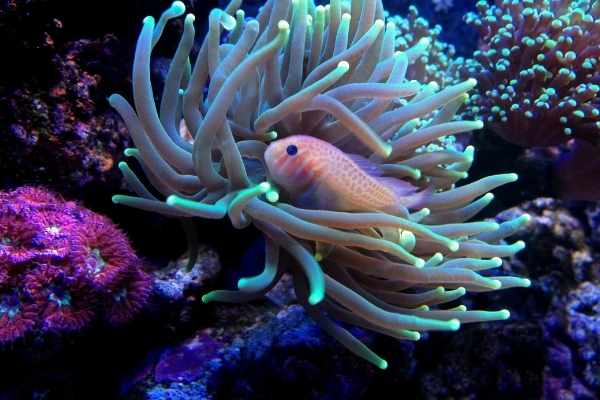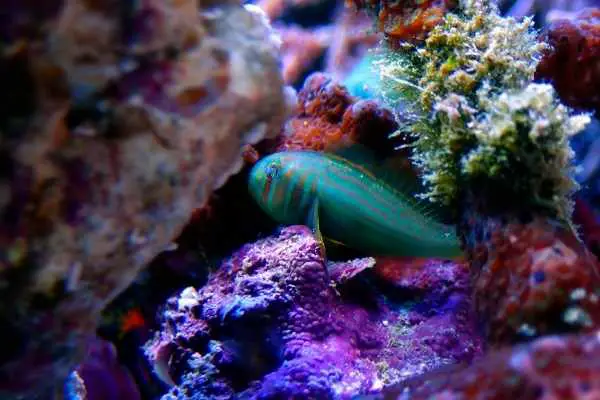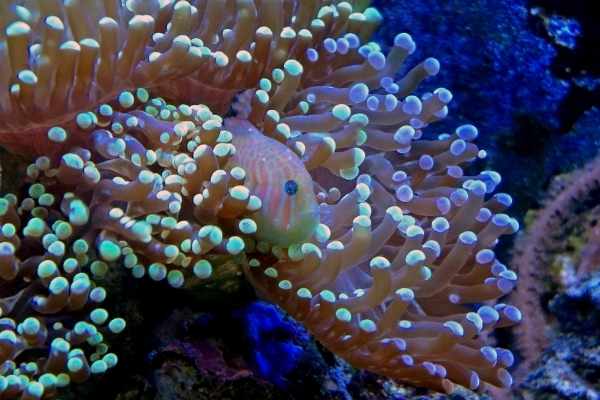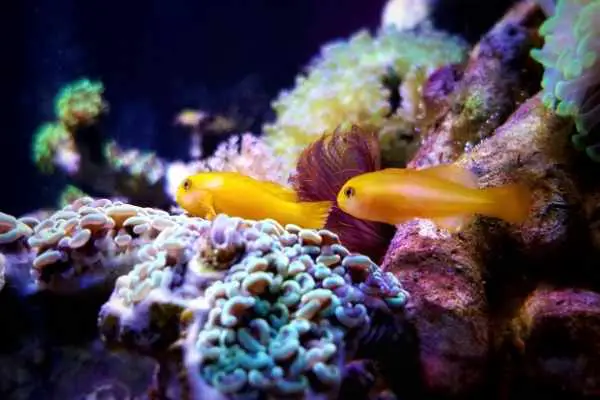The clown goby (Gobiodon spp.) charms people with a combination of its tiny size, cute shape, and dazzling array of colors. You don’t need to break the bank to add one – or even a pair – to your display reef tank, either. And under ideal conditions, they’ll add the perfect touch of activity. You just need suitable corals for the job.
Table of Contents: Clown Goby Care
Of course, you’re probably dying to drop down and click on the link to figure out what corals have to do with the clown goby. And you’re free to do that. If you want to ensure success with this minuscule addition to the saltwater aquarium hobby, though, you may want to read through the entire article.
- Quick Facts
- Description of the Clown Goby
- Clown Goby Lifespan
- Creating the Ideal Clown World
- Clown Goby Diet
- Clown Goby Behavior and Tank Mates
- Breeding the Clown Goby
- Pros and Cons
- For More Information
Quick Facts
- Common Names: Clown goby, Earspot coral goby, Green clown goby, Citrinis clown goby, Citron goby, Citrin goby, Gumdrop goby, Green coral goby, Broad-barred goby, Blue-spotted coral goby, Acropora goby, Panda goby, War paint clown goby
- Scientific Names: Gobiodon spp.
- Size: Up to 2 inches (5cm)
- Minimum Tank Size: 10 Gallons (38L)
- Reef Safe? Yes
- Care or Experience Level: Easy
- Preferred Diet: Carnivore
- Original Part of the World: Indo-Pacific

Description of the Clown Goby
Where’d the name “clown goby” come from? Two different sources, actually. To begin with, all of the species tend to sport colorful markings over their faces and bodies, reminiscent of a clown’s face painting. Then you have those large, round heads that put people in mind of clownfish. Put the two together, and you get a clown goby.
But you can’t neglect their typical goby features. The ventral fins are modified into a kind of suction cup. This allows these tiny fish to grasp and hold to their corals in the ocean currents. It’s an essential adaptation for a fish that would otherwise end up swept out to sea.
And when you’re small enough to serve as “popcorn shrimp” for the predators on the reef? You need another defense. Most of the clown goby species lack scales. Instead, you find smooth sides covered in thick, toxic mucus. It tastes HORRIBLE to fish that attempt to snack on these colorful gobies, affording them a chance to escape.
Clown gobies participate in commensal relationships with coral species. They pick off pests from the branches of Acropora corals (hence that common name of Acropora goby) while using the polyps as a safe harbor – for themselves and their eggs. Of course, you can also find them on a few other popular coral choices:
- Echinopora (chalice corals)
- Hydnophora
- Stylophora
You have a few popular choices when it comes time to select your clown goby. All of them have peaceful temperaments without growing terribly large. It makes them ideal choices for aquarists looking to start a nano aquarium. And with those adorably round faces? You’re spoiled for choice:
- Black clown goby (Gobiodon ceramensis): If you aren’t attracted to dramatic color patterns, this is the clown goby for you. As you might guess, they have a sleek midnight look.
- Citron goby (Gobiodon citrinus): Coming out as the largest of the clown goby group, these fish have yellowish-brown sides. Then you’ll see four blue bands across the head and along the dorsal and anal fins. They also have a black spot on the operculum.
- Green clown goby (Gobiodon histrio): You can see a base color of yellow to greenish-tan despite the name. Then you have orange-red stripes patterned over the head and yellow bands on the fins, trimmed in a thin line of black. You’ll find two varieties of this clown goby: one with a black spot on the operculum and one without.
- Rippled coral goby (Gobiodon rivulatus): You may see this particular clown goby show up under the name citron goby, but when you look closer? The fish won’t have the blue stripes on the fins. And the lines on the head continue down the body.
- Yellow clown goby (Gobiodon okinawae): No one can miss the bright yellow of this clown goby, setting off the blue stripes around the eyes and gills. You’ll also note a single blue line down the dorsal fin. They have one of the biggest personalities in the group.

Clown Goby Lifespan
The clown goby species cover the majority of the Indo-Pacific, even stretching into the Red Sea. If they can find their preferred coral host to settle into? They’ll happily colonize a region. Divers often spot their round faces peering out from among the branches and polyps, watching for the next meal (or making sure the coast is clear).
Unfortunately, when you’re a small fry (even a toxic small fry), you don’t get the longest lifespan. The clown goby usually only lives for around 2-6 years, depending on the quality of their care. As they often DON’T ship well and arrive in fish stores emaciated, some aquarists find themselves with gobies that only last a couple of years.
Creating the Ideal Clown World
Due to the symbiotic relationship with their corals, the clown goby stays relatively shallow throughout its range. They’re not found too far outside of the depths of 5-60 feet (1.5-18.2m). The abundant corals on the reefs provide the best environments for them to move around and thrive. And if you want your clown goby to have the best chance for survival and health, you WILL want to set up your tank with appropriate coral choices.
However, you don’t have to commit to keeping Acropora. Clown gobies will happily accept any small polyp stony (SPS) species or even soft corals as a substitute. And you can (in theory) get away with setting up a tank WITHOUT coral – provided you supply enough live rock for your fish to hide within and perch on. But without their preferred host, you may not see the same level of activity. At best, you can expect to spot a round face peering out at you from the safety of a cave.
As it’s a simple task to find corals out there that are easy to manage and care for, you may want to go that route and keep your clown goby happy.
While these gobies spend most of their time perched in stony branches, they DO take occasional jaunts across the sand. And without scales to protect them, the wrong substrate can pose a threat to their mucus layer. As the slime coat gets scraped away by crushed coral or large-grained sand, the fish needs to consume more calories to replace it. Not a problem if you’re providing extra food, but tricky if you haven’t noticed.
You can avoid potential issues by using sand or soft rock. Live sand will work nicely as it won’t harm that mucus, AND it’ll provide a handy source of food for your clown goby. Then you’ll also get to see your fish hop around the bottom. (And who wants to miss out on that opportunity?)

Clown Goby Tank Size
As one of the smallest species kept in the saltwater aquarium hobby, the clown goby often goes into nano aquarium setups. And, in theory, as long as you’re providing that coral perch, you CAN get away with 10 gallons (38L). However, this won’t offer much room for your goby to explore or move around.
If you want to allow the best space – for the coral colony, if nothing else – upgrade to at least 30 gallons (114L). You’ll have room for your corals, live rock, and open sand. This will encourage all of the activities your clown goby’s capable of. And then you won’t have to resign yourself to an occasional glimpse here and there.
Whichever tank size you go with, you need to make some preparations FIRST. Clown gobies are itty-bitty, which makes for some HUGE problems. You need to cover your filter intakes with netting, so your fish don’t get caught up. Gobies have enough strength to “burst” off the net. But if they get sucked into the tube? There’s no escape. (They lack Nemo’s resolve)
And that small burst of swimming power in a prey species means you need a tight lid – with EVERY hole covered. Think of how tiny your clown goby is. A gap of even a QUARTER INCH (0.64cm) is enough for a fish to slide through and carpet surf. And that’s usually the space you have around your heater or flow box. Mesh netting will do the trick and prevent accidental escapes.
Are Clown Gobies Reef-Safe?
You know about the clown goby-Acropora symbiosis. So that means the species are reef-safe, right? And they are, but you need to keep a couple of things in mind.
A couple of the species nip on the polyps of the coral they live within. They’re feeding on the mucus the coral produces. In a large reef tank, heavily stocked with mature colonies, a fish the size of a clown goby isn’t going to wreak havoc with this habit. But if you have a nano aquarium with a few sporadic colonies? That could spell disaster.
Clown gobies are also known to spawn in captivity (which we’ll get to in a minute). They lay eggs along the underside of coral tentacles, forcing the polyps to recede. It CAN lead to damaged tissue. Most corals regenerate after the eggs hatch without a problem. But you still want to keep this in the back of your mind. (Again, it depends on the size and health of your setup)

Clown Goby Diet
With small mouths and equally small teeth, you can imagine that the clown goby isn’t devouring huge meals. As reef carnivores, they snap up meaty morsels from the plankton. And they aren’t difficult to formulate a meal for in the home aquarium – provided you have gobies that WANT to eat. Unfortunately, you often end up with fish that refuse. And getting their appetite jumpstarted can get tricky.
Start by looking for healthy clown gobies in the fish store. You DON’T want the skinny, emaciated specimens. Those fish aren’t long for the world, and you may never get them to recover. If you can, ask the store owner to offer food while you’re there. Watch to see which goby takes an interest.
You may need to start with live food for your new clown goby. And that means gut-loaded brine shrimp. Once you have them readily striking at food, you can transition them to frozen options:
- Chopped crustacean flesh
- Chopped mollusk flesh
- Cyclops
- Fish Frenzy
- Mysis shrimp
In the wild, a clown goby will constantly feed throughout the day. But in aquariums, this doesn’t work. You’ll need to hand-feed them. Offer food until they stop “striking.” And don’t be surprised if the amount changes from day to day. As long as your goby’s shape remains round, they’re getting enough food. You DON’T want to see a skinny clown goby.
Clown Goby Behavior and Tank Mates
The clown goby congregates in schools of anywhere from 5-20 fish on a reef. They dash in and out of the coral, hunting for plankton and looking out for potential threats. The presence of these vibrant fish provides defense against potential coral nibblers, too. (Remember, the mucus they produce tastes horrible) These gobies get along well together – of course, there’s plenty of room in the ocean.
You CAN keep multiple clown gobies together if you have space. But if you’re setting up a nano aquarium, opt for a single goby or a pair. (No need to fuss over whether you have a male or female – you’ll end up with a breeding pair. We’ll explain in a minute) If you don’t have room for all of your clown gobies to set up individual territories, complete with corals, you’ll end up with fights breaking out. And just because they have tiny teeth doesn’t mean they can’t leave scratches in that mucus coat.
When setting up a community, you need to keep that minuscule size in mind. Sure, the clown goby tastes terrible (supposedly – can’t speak from personal experience), but do you want to force your fish to endure getting snapped up to test that out? Of course not. So choose tank mates that won’t attempt to swallow your clown goby:
- Anthias
- Assessors
- Blennies
- Cardinalfish
- Dragonets
- Filefish
- Grammas
- Hamlets
- Jawfish
- Pipefish
- Seahorses
- Tilefish
Along the same lines, don’t try to mix them with potential predators. Even if you have coral around for the clown goby to dive into, you don’t want to tempt fate. So keep these known hunters out of the mix (or at least in a separate display tank):
- Frogfish
- Groupers
- Hawkfish
- Lionfish
- Pufferfish
- Scorpionfish
- Squirrelfish
- Toadfish
- Waspfish

Breeding the Clown Goby
Most protogynous hermaphrodite fish species change sex once. They’re born female and change to male with specific social cues. But the clown goby demonstrates bi-directional sex changes. This means that regardless of WHAT sex a pair of fish happens to be, you’ll always end up with a male and female. The larger will always end up male, while the smaller becomes female (unless, of course, they’re already two different sexes).
Getting the clown goby to spawn in captivity is a cinch, provided they have enough space. All you need is a tank of at least 100 gallons (379L) with an appropriate SPS coral. (Of course, making sure you don’t have fish speeding past all the time and scaring your gobies to death helps, too) You can also encourage a spawning event by increasing your tank’s water temperature a couple of degrees.
The female attaches bands of eggs (up to 1000!) around the tentacles of the pair’s host coral. The male fertilizes the eggs and sets up as a guard. The eggs hatch around five days later in the evening. And that’s when the tricky part sets in. Breeding clown gobies is easy. But raising the fry is a different matter altogether. While the parents attempt to defend their offspring, most goby fry don’t survive unless they’re removed from the community tank.
The tank for the clown goby fry needs the same water parameters as the display tank. And you need to cover EVERY intake to protect them. For the first two weeks, they’ll need a diet of rotifers. Then you’ll want to transition them to a mixture of rotifers and brine shrimp nauplii. By day 25, it’s time to stop the rotifers. And by day 40, you can add dried food to the mix. You’ll know you’ve hit this milestone by the development of the clown goby colors.
While the fry are growing, the tank needs TWO 50% water changes every week. Of course, you don’t want to accidentally remove any baby clown gobies, so you’ll want to protect them in a sieve. Use slow suction, though, or the fry will end up adhered to the sieve. (Think bugs on a windshield – not a good thing)
Once the fry develop their colors, they’re large enough to join the community and find their own coral perches.
Pros and Cons
The clown goby species offer plenty of positives – but they also come with some negatives. And if you’re considering bringing one into your display tank, you’ll want to make sure you look at both sides of the coin.
Pros
- The clown goby forms symbiotic relationships with coral species (Acropora most often), but they CAN tolerate existing in a tank without, provided you offer plenty of live rock structures.
- Clown gobies are reef-safe, though smaller setups may lead to problems.
- Undergoing bi-directional sex changes, any two fish will produce a mated pair.
Cons
- The clown goby species don’t adapt to captive care well and often arrive in fish stores emaciated and stressed.
- The toxic mucus coating of the clown goby can end up scratched and damaged by rough substrates, requiring additional nutrition and calories to replace.
- Due to their size, clown gobies often find themselves on the menu for many other fish – whether their mucus coating fends off the predator or not.
For More Information
Whether they put you in the mind of a circus clown or your favorite clownfish species, odds are you’ve sought after a clown goby once you’ve caught a glimpse of one. And learning more about these little coral-dwellers? That’s icing on the cake!
This YouTube video tells you even more about the clown goby:
Want to know about some of the best clown goby tank mates?
Even if they aren’t the adorable clown goby, maybe you’re intrigued by other gobies:
Conclusions
The clown goby makes an active and curious addition to any reef tank. Even if you aren’t interested in struggling to raise their horde of infants, you can’t go wrong with watching the fish dart in and around coral branches, cleaning the polyps. And, really, how do you say no to those adorable faces? As long as you’re prepared to meet their particular care needs, you’re golden.
References
- “Gobiodon histrio.” Tropical Fish Hobbyist Magazine.
- Lieske, E. and Myers, R. 1996. Coral Reef Fishes.
- Michael, S.W. 1999. Marine Fishes: 500+ Essential-to-Know Aquarium Species.
- Myers, R.F. 1991. Micronesian Reef Fishes.
- Randall, J.E., Allen, G.R., and Steene, R.C. 1990. Fishes of the Great Barrier Reef and Coral Sea.


Leave a Reply